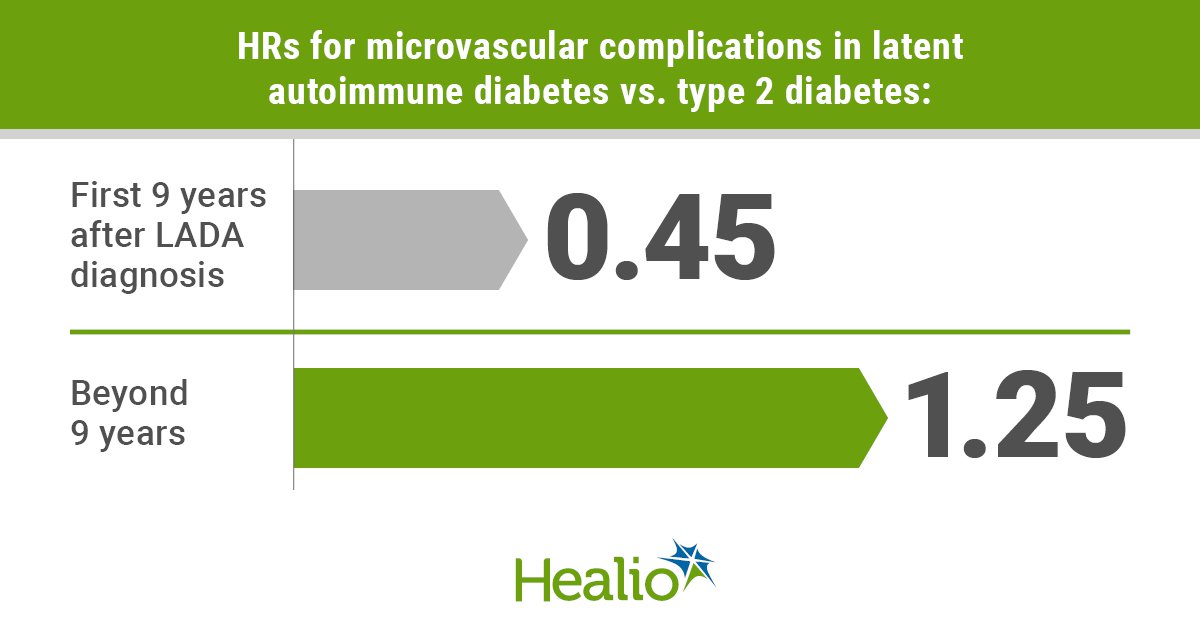Increased complications in latent autoimmune diabetes warrant ‘tailored screening strategies’
Click Here to Manage Email Alerts

Adults with latent autoimmune diabetes are 25% more likely to develop microvascular complications beginning in the decade after diagnosis when compared with adults with type 2 diabetes, suggesting that early identification through the measurement of diabetes-related autoantibodies can help reduce risk for adverse outcomes, according to findings from a post hoc analysis published in The Lancet Diabetes & Endocrinology.
“Although initially at a 55% lower risk for microvascular disease than patients with type 2 diabetes, people with latent autoimmune diabetes show a 25% increased risk for microvascular disease beyond 9 years after diagnosis,” Ernesto Maddaloni, MD, PhD, a senior research fellow with the experimental medicine department at Sapienza University of Rome and the diabetes trial unit at the Oxford Centre for Diabetes, Endocrinology and Metabolism at the University of Oxford, United Kingdom, told Healio. “This change in the microvascular risk over time is explained by the sustained worse glycemic control observed in patients with latent autoimmune diabetes. An early identification of patients with latent autoimmune diabetes may help for a better microvascular risk stratification in adult-onset diabetes.”
Maddaloni and colleagues analyzed data from 5,028 adults with diabetes autoantibody measurements available and without microvascular events at baseline, using 30-year follow-up data from the UK Prospective Diabetes Study (UKPDS), a database of adults aged 25 to 65 years with newly diagnosed type 2 diabetes. Participants with at least one detectable autoantibody were identified as having latent autoimmune diabetes (LADA); those who tested negative for all autoantibodies were identified as having type 2 diabetes. Primary composite microvascular outcome was first occurrence of renal failure, renal death, blindness, vitreous hemorrhage or retinal photocoagulation compared between adults with LADA vs. those with type 2 diabetes.

Within the cohort, 564 adults had LADA and 4,464 had type 2 diabetes.
After a median 17.3 years of follow-up, the composite microvascular outcome occurred in 1,041 (21%) participants. The incidence for the composite microvascular outcome was 15.8 per 1,000 person-years (95% CI, 13.4-18.7) among adults with LADA and 14.2 per 1,000 person-years (95% CI, 13.3-15.2) among adults with type 2 diabetes.
Researchers found that adults with LADA had a lower risk for the composite outcome during the first 9 years of follow-up vs. those with type 2 diabetes, with an adjusted HR of 0.45 (95% CI, 0.3-0.68). However, beyond 9 years, risk for adults with LADA was 25% higher compared with adults with type 2 diabetes (HR = 1.25; 95% CI, 1.01-1.54).
Researchers found that a model adjusting for the higher updated 9-year mean HbA1c observed in adults with LADA accounted for the subsequent increased risk for the composite microvascular outcome.
Among the adults with LADA, 482 (85%) had only one detectable autoantibody and 82 (14%) were double autoantibody positive, according to researchers.
“This study provides insights into the association between diabetes heterogeneity and microvascular complications and might allow tailored screening strategies,” Maddaloni said. “Our results highlight the existence of an early therapeutic window in latent autoimmune diabetes to improve microvascular outcomes by implementing strict glycemic control.”
Maddaloni said there is a need for novel clinical risk scores to guide clinicians toward the identification of patients with a high pretest probability of being affected by LADA, warranting measurement of diabetes autoantibodies. – by Regina Schaffer
For more information:
Ernesto Maddaloni, MD, PhD, can be reached at the Department of Experimental Medicine, Endocrinology and Diabetes, Sapienza University of Rome, Viale Regina Elena 324, 00161, Rome, Italy; email: ernesto.maddaloni@uniroma1.it.
Disclosures: The study was funded by a grant from the European Foundation for the Study of Diabetes (EFSD) supported by AstraZeneca. Maddaloni reports he has received grants from scientific societies supported by AstraZeneca and Eli Lilly and honoraria from Abbott, AstraZeneca, Merck-Serono and Pikdare. Please see the study for all other authors’ relevant financial disclosures.
